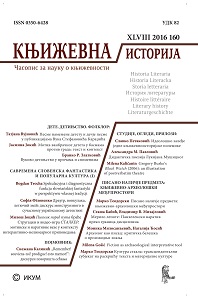Мотив ванбрачног детета у басмама против града: текст и контекст
The Motif of a Child Born Out of Wedlock in Charms Against Hale: Text and Context
Author(s): Jasmina S. JokićSubject(s): Customs / Folklore, Serbian Literature
Published by: Институт за књижевност и уметност
Keywords: anti–hail “basmas“;meteorological magic;miracle;child out of wedlock;souls of unbaptized children;weaving;spinning
Summary/Abstract: The paper is based on the presumption that the Serbian traditional culture has preserved the ancient images of children as a kind of mediums between this and the other world and that this is why they frequently take part in rituals aimed at altering the weather, i.e. preventing hail, heavy rainfall, floods and even draft. Therefore, the first part of the paper discusses the individual segment of the ritual practice, on the basis of numerous ethnographic sources. Toddlers were mainly assigned the role of passive participants since the main magical rituals were performed by adults, most often women: mothers shook their babies in cradles and waved them against the clouds, older women iterated magical texts (charms), while simultaneously carrying the child in front of the house and throwing him into the air three times, or strippinghim naked and letting him run around the house three times, or run in the field, etc. The spoken magical texts contain the motif of a child born out of wedlock and its predominance is a testimony to the meaning and importance of the beliefs found in the subtext, which even the performers are often unaware of. Therefore, we place a special focus on the widely acclaimed representations and beliefs about the influence certain categories of children (the ones born out of wedlock or deceased before the baptism) have on the occurrence of the unwanted weather conditions.Namely, beliefs about children who have died immediately after birth are basically comprised of the fear of their souls, which having been condemned to eternally roam between two worlds can be detrimental to the community in various ways,e.g. by attracting hail clouds. That is why traditional communities act in any possible way to prevent the tragic consequences of such children’s deaths, mainly through the ritual destruction or relocation of children’s bodies away from the boundaries of their space. During these rituals, certain magical texts are iterated, the content of which is the concealment of the unmarried mother’s moral transgression (giving birth out of wedlock and infanticide), or the negation of the transgression by hiding the body into a “foreign land“, while the spoken charms present the best form of protection against the hail clouds formed after a child out of wedlock is born.Although it seems paradoxical and utterly contradictory to the aforementioned beliefs,a more thorough analysis of the lyrics reveals their true meaning. Namely, it is a common characteristic of the majority of spells and rituals performed upon the occurrence of any such immediate threat that they have an upside–down logic – the usual norms and behavior patterns are substituted with their opposites, with the aim of achieving the desired magical effect.
Journal: Књижевна историја
- Issue Year: 48/2016
- Issue No: 160
- Page Range: 27-47
- Page Count: 21
- Language: Serbian

